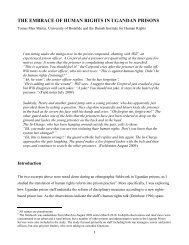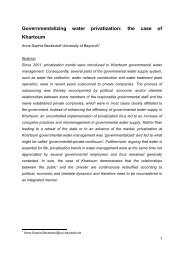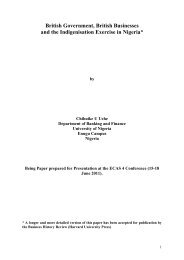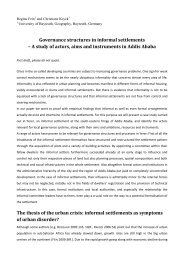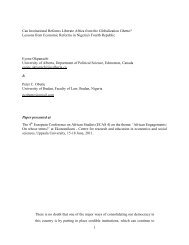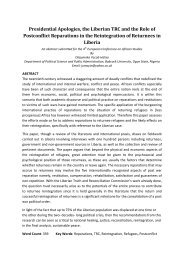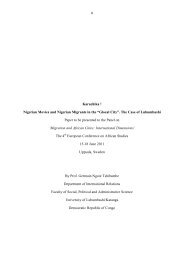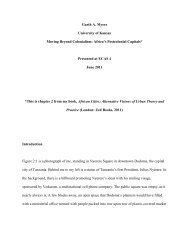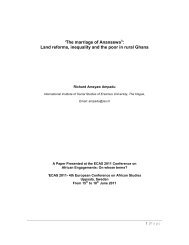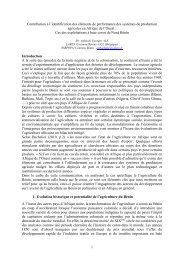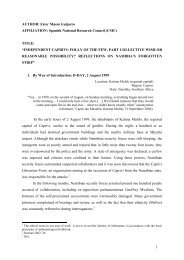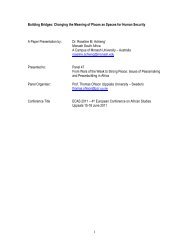Johanna Jansson - Full paper - The Nordic Africa Institute
Johanna Jansson - Full paper - The Nordic Africa Institute
Johanna Jansson - Full paper - The Nordic Africa Institute
Create successful ePaper yourself
Turn your PDF publications into a flip-book with our unique Google optimized e-Paper software.
Draft version, please do not cite without the express permission of the author<br />
______________________________________________________________<br />
Recipient government control under pressure:<br />
<strong>The</strong> DRC, the IMF, China and the Sicomines negotiations<br />
Paper presented at the 4 th European Conference on <strong>Africa</strong>n Studies<br />
15-18 June 2011, Uppsala, Sweden<br />
Panel 7: Aid as a Means of Power for Developing States?<br />
By <strong>Johanna</strong> <strong>Jansson</strong><br />
Department of Society and Globalisation, Roskilde University<br />
johannaj@ruc.dk<br />
1
Draft version, please do not cite without the express permission of the author<br />
______________________________________________________________<br />
Abstract<br />
This <strong>paper</strong> seeks to contribute to ongoing debates around <strong>Africa</strong>n countries‟ relations to their external<br />
partners. It explores the notion of recipient government control, here defined as the extent to which a<br />
recipient government is able to ensure that the outcome of negotiations with its external development<br />
partners is in line with its agenda. <strong>The</strong> <strong>paper</strong> focuses on the Democratic Republic of Congo (DRC),<br />
interpreting the extent to which the Congolese government was able to ensure that the outcome of the<br />
different phases of the 2007-2009 negotiations over the Sicomines agreement was in line with its<br />
agenda. <strong>The</strong> Sicomines agreement is a barter setup by means of which a Sino-Congolese joint venture<br />
has been granted mining titles in exchange for the large-scale provision of infrastructure projects<br />
funded by China Exim Bank loans. <strong>The</strong> agreement was contested by the traditional donors who, among<br />
other things, cited concerns for debt sustainability. <strong>The</strong> <strong>paper</strong> argues that in the early stages of<br />
negotiations with China during 2007-2008, the Congolese government exercised control in the sense<br />
that the 2008 version of the Sicomines agreement made sizeable amounts of funding available towards<br />
large-scale infrastructure refurbishment, a key feature of the government‟s agenda at the time. During<br />
the 2008-2009 renegotiation phase, the Congolese government‟s ability to exercise control was<br />
gradually weakened due to pressure from the traditional donors to rearrange priorities and move<br />
macroeconomic concerns, notably debt sustainability, higher up on the agenda. Moreover, during this<br />
phase, the Chinese government‟s attitude towards the agreement came to change due its growing<br />
aspirations as a responsible international actor. <strong>The</strong> Chinese ambition to take up a more active role in<br />
the IMF board is of particular relevance here, since it reduced its willingness to push ahead with the<br />
criticised version of the Sicomines agreement. Eventually, mid-2009, President Kabila accommodated<br />
the concerns of the traditional donors. <strong>The</strong> agreement was reduced and HIPC completion point was<br />
subsequently reached in July 2010. It is not known whether Kabila felt forced to accept this change of<br />
agenda given a lack of realistic alternatives, or whether it was a genuine change of priorities brought<br />
about by the lobbying efforts of the IMF and the traditional donors. In any case, the final settlement<br />
was in line with Kabila‟s modified agenda to secure both Chinese funding and HIPC debt relief. <strong>The</strong><br />
<strong>paper</strong> thus concludes that recipient government control was retained, although it was under heavy<br />
pressure.<br />
2
Draft version, please do not cite without the express permission of the author<br />
______________________________________________________________<br />
1. Introduction<br />
This <strong>paper</strong> seeks to contribute to ongoing debates around <strong>Africa</strong>n countries‟ relations to their external<br />
partners. It focuses on recipient government control, here defined as the extent to which a recipient<br />
government is able to ensure that the outcome of negotiations with its external development partners is in line with its<br />
agenda. <strong>The</strong> Democratic Republic of Congo (DRC) is a conflict-ridden and highly aid-dependent<br />
country with a large external presence on its territory, both in the form of donors and peacekeepers 1<br />
but also in terms of foreign rebel groups and investors in the country‟s mining- and oil sectors. In this<br />
context, the Congolese government‟s ability to exercise control in the relation to its external<br />
development partners is an important yet under-researched topic. This <strong>paper</strong> contributes with a case<br />
study of the Sicomines agreement, which has become one of the most well-known embodiments of the<br />
increasing Chinese presence on the <strong>Africa</strong>n continent. It is a barter arrangement first conceived in 2007<br />
by means of which a Sino-Congolese mining joint venture, Sino-Congolais des Mines (Sicomines), was<br />
provided access to mining concessions in the DRC‟s mineral-rich, south-eastern Katanga province. In<br />
exchange for the acquisition of the mining titles, Sicomines will construct transport- and social<br />
infrastructure worth US$ 3 billion in the DRC, financed by loans from state-owned China Export-<br />
Import (Exim) Bank. <strong>The</strong> loans are subsequently to be reimbursed by means of the income from the<br />
mining venture. Further details around the agreement, and the context within which it was negotiated,<br />
renegotiated and settled, follow below.<br />
Investigation of the Sicomines case with a view to specifically examine recipient government control<br />
has not yet been carried out. <strong>The</strong> aim of this <strong>paper</strong> is thus to interpret the extent to which the Congolese<br />
government was able to ensure that the outcome of the different phases of negotiations over the Sicomines contract was in<br />
line with its agenda. <strong>The</strong> <strong>paper</strong> argues that in the early stages of negotiations with China during 2007-2008,<br />
the Congolese government exercised control in the sense that the 2008 version of the Sicomines<br />
agreement made sizeable amounts of funding available towards large-scale infrastructure refurbishment,<br />
a key feature of the government‟s agenda at the time. During the 2008-2009 renegotiation phase, the<br />
Congolese government‟s ability to exercise control was gradually weakened due to pressure from the<br />
traditional donors to rearrange priorities and move macroeconomic concerns, notably debt<br />
sustainability, higher up on the agenda. Eventually, mid-2009, President Kabila accommodated the<br />
concerns of the traditional donors. It is not known whether Kabila felt forced to accept this change of<br />
agenda given a lack of realistic alternatives, or whether it was a genuine change of priorities brought<br />
about by the lobbying efforts of the IMF and the traditional donors. In any case, the final settlement<br />
was in line with Kabila‟s modified agenda to secure both Chinese funding and Highly Indebted Poor<br />
1 Development aid accounted for roughly half of the US$ 4.9 billion national budget in 2009 (AfDB 2010, Ministry of<br />
Budget 2009) and the United Nations‟ (UN) largest peacekeeping mission la Mission de l’Organisation des Nations Unies pour la<br />
stabilitation en République Démocratique du Congo (known by its acronym Monusco) of 19 995 uniformed personnel is operating<br />
in the country.<br />
3
Draft version, please do not cite without the express permission of the author<br />
______________________________________________________________<br />
Country (HIPC) debt relief. <strong>The</strong> <strong>paper</strong> thus concludes that recipient government control was retained,<br />
although it was under heavy pressure.<br />
<strong>The</strong> Chinese presence in the DRC is a multifaceted phenomenon involving both small and large<br />
companies, state-owned and private, as well as development aid and concessional finance funded<br />
projects. This <strong>paper</strong> does, however, not go in-depth in terms of the details, drivers and implications of<br />
these processes. For an overview, refer to <strong>Jansson</strong> et al (2009). Indeed, given the magnitude of the<br />
Sicomines agreement it raises a great deal of concerns which deserve analytical attention, such as the<br />
environmental implications of and labour practices in the mining operation, equity in the agreement<br />
formulation (to what extent is the final version of the contract a „good deal‟ for the DRC?) and perhaps<br />
most importantly, it needs to be contextualised (is the Sicomines agreement unique? Which features in<br />
the negotiations and in the anticipated implications can be observed also in earlier comparable<br />
situations in the DRC and elsewhere?). This, however, is beyond the scope of this <strong>paper</strong>.<br />
This <strong>paper</strong>‟s definition of recipient government control concerns a recipient government‟s<br />
negotiations with its „external development partners‟. <strong>The</strong> notion of a development partner is often<br />
used to denote a traditional aid donor. Donations and grants only make up a small share of China‟s<br />
assistance to the DRC, which by far and large is provided in the form of concessional loans (<strong>Jansson</strong><br />
2009:11-19, 33-38). Yet, the relation to China is currently one of the (if not the) most important to the<br />
Congolese government, both politically and financially. China provides assistance in areas crucial to the<br />
DRC‟s development, notably in terms of transport- and social infrastructure. <strong>The</strong>refore, this <strong>paper</strong><br />
regards also China as one of the country‟s external development partners.<br />
Furthermore, for this <strong>paper</strong>‟s definition of recipient government control, the term „agenda‟ is used in<br />
lieu of other notions such as „development strategy‟ or „developmental priorities‟ that could possibly be<br />
employed. <strong>The</strong> idea is to be able to also capture motivations that may be informed by narrow<br />
enrichment- or power conservation considerations and not just concerns for development or „the<br />
common good‟. This draws on Whitfield and Fraser‟s definition of ownership as control, the intention<br />
of which is simply to analyse the degree of control exercised, and not to “judge policy outcomes as<br />
good or bad” (2009:5).<br />
Before embarking on an analysis of the Congolese government‟s agenda in relation to the Sicomines<br />
agreement, it is important to mention that in this context, the Congolese government‟s agenda more or<br />
less equals President Kabila‟s agenda. <strong>The</strong> Congolese Prime Minister‟s office is heavily subordinated to<br />
the Presidency, and any portfolios or decisions deemed important by the Presidency, particularly<br />
security related issues and the allocation and management of (significant) oil- and mining concessions,<br />
are dealt with by a small circle of key stakeholders around the President. Given the political and<br />
financial weight of the Sicomines agreement (discussed further below), it has been managed by the<br />
Presidency in a most secretive and exclusive fashion. 2 Thus, even though this analysis nominally<br />
concerns the Congolese government‟s agenda, it is rather the agenda of President Kabila and his<br />
advisors that is being examined.<br />
2 Interviews, October 2008, February-March 2009, October 2009 and February-May 2011, Kinshasa.<br />
4
Draft version, please do not cite without the express permission of the author<br />
______________________________________________________________<br />
<strong>The</strong> <strong>paper</strong> is structured as follows. Section 2 provides an overview of the developments around the<br />
Sicomines negotiations. Section 3 analyses the Congolese government‟s agenda at the time of the<br />
inception of the Sicomines agreement. Section 4 explores the change in this agenda that took place in<br />
May 2009. Section 5 provides a concluding discussion around recipient government control,<br />
interpreting the extent to which the Congolese government was able to ensure that the outcome of the<br />
different phases of negotiations over the Sicomines contract was in line with its agenda.<br />
1.1 Methods and data<br />
<strong>The</strong> analysis draws on empirical data collected by the author during field work in Kinshasa and<br />
Lubumbashi, DRC in October 2008, February-March 2009, October 2009 and February-May 2011.<br />
During these periods, a total of around 130 semi-structured interviews were conducted with Congolese,<br />
Chinese, Indian and South Korean stakeholders as well as with respondents from other <strong>Africa</strong>n<br />
countries and from Western countries. <strong>The</strong> interviews pertained to several different aspects of the<br />
DRC‟s external relations. While observations from the ensemble of the interviews informs the analysis,<br />
the specific topic at hand, the Sicomines negotiations, was the subject for around 50 of the interviews<br />
conducted. <strong>The</strong> lion‟s share of the interviews with Chinese stakeholders was conducted in collaboration<br />
with Professor Jiang Wenran of the China <strong>Institute</strong>, University of Alberta, Canada. Professor Jiang‟s<br />
contribution is gratefully acknowledged.<br />
<strong>The</strong> interviews filled a dual role. First, they sought to establish and cross-check facts around the<br />
empirical developments at hand, an important part of the field research given that little previous field<br />
work has been carried out by scholars and other observers on the topic, and little information is<br />
available. Second, the interviews sought to gain insights in terms of how respondents from different<br />
countries and sectors understand and interpret the developments, politically as well as analytically.<br />
Congo‟s external relations, particularly the relation to China, is a politically sensitive topic, and most<br />
interviews were conducted under the condition of anonymity. Many of the respondents would not<br />
share their full analysis of the developments with me unless they received guarantees that they would<br />
not be identifiable in my publications. For the same reasons, the interviews were not recorded, but<br />
extensive notes were taken and any direct quotes used in the <strong>paper</strong> were written down word for word<br />
during the interviews.<br />
2. <strong>The</strong> Sicomines agreement<br />
This section tells the story of the Sicomines agreement, an unconventional combination of a large-scale<br />
mining venture and comprehensive funding towards infrastructure refurbishment. <strong>The</strong> agreement has<br />
become well-known a result of the magnitude of the agreement - US$ 9 billion in the initial version -<br />
and due to the international controversy that followed its signature. This overview is divided into two<br />
5
Draft version, please do not cite without the express permission of the author<br />
______________________________________________________________<br />
parts. <strong>The</strong> first discusses the conception of the agreement and the initial negotiations between the<br />
Congolese and Chinese parties. <strong>The</strong> second analyses the international controversy around the<br />
agreement and outlines the final settlement.<br />
2.1 Conception and Sino-Congolese negotiations (2007-2008)<br />
<strong>The</strong> Sicomines episode started in 2007 when the Chinese state-owned enterprise (SOE) China Railway<br />
Engineering Corporation (CREC) came to the DRC in search of mining concessions. At this moment<br />
in time, CREC - one of the world‟s largest construction companies - was implementing its<br />
diversification strategy: to expand into resource extraction activities. <strong>The</strong> company was allocated the<br />
copper- and cobalt concessions Dikuluwe, Mashamba and Dima 3 in Kolwezi to be exploited in joint<br />
venture (JV) with Gécamines, one of the DRC‟s mining parastatals. 4 A first memorandum of<br />
understanding (MOU) (protocol d’accord) between the Chinese and Congolese parties was signed on the<br />
17 th September 2007. It stated that a joint venture between the DRC‟s Gécamines (with a 32 percent<br />
stake) and a consortium of Chinese companies (with a 68 percent stake 5 ) was to be formed under the<br />
name of Sicomines. <strong>The</strong> consortium of Chinese companies was to comprise CREC as well as the<br />
Chinese SOE Sinohydro, the company behind the Three Gorges Dam in China. 6 Initially, CREC‟s<br />
intention was to engage in a regular mining project, but when discussions started around the setup of<br />
the mandatory JV with Gécamines, the Congolese party suggested that the project would include an<br />
infrastructure component. 7 <strong>The</strong> MOU was thus, unconventionally, structured according to a barter<br />
principle. In exchange for access to mining titles, the consortium of Chinese companies would provide<br />
the DRC with turnkey transport- and social infrastructure projects funded by loans from China Export-<br />
Import (Exim) Bank. <strong>The</strong> reimbursement of these loans would be tied directly to the revenues from<br />
Sicomines‟ mining operation, thus ensuring repayment. This original setup remains the same to date,<br />
although the amounts, the concessions and other details of the agreement were gradually renegotiated<br />
between 2007 and 2009, as indicated in Box 1.<br />
3 For more details on the mining concessions, refer to the contract (Convention de Collaboration), pp. 30-32. Available on<br />
http://www.globalwitness.org/sites/default/files/library/China-<br />
DRC%20April%202008%20contract%20French%20and%20Chinese_0.pdf<br />
4 All mining ventures in the DRC have to take place in a joint venture (JV) with one of the country‟s mining parastatals:<br />
Gécamines and Sodimico (copper and cobalt), MIBA (diamonds), Okimo (gold), Sominki (gold and cassiterite) and<br />
Entreprise Minière de Kisenge (manganese). <strong>The</strong> JVs are generally set up with the foreign investor as a majority owner.<br />
5 In interviews, the relevant Chinese respondents preferred not to share the exact internal partition of the stakes between the<br />
Chinese companies. However, it was stated that CREC has the largest share, followed by Sinohydro, then CMEC (China<br />
National Machinery & Equipment Import & Export Corporation) and last Zhejiang Huayou Cobalt, which has a fairly small<br />
share. Interviews, 07.03.2011 and 03.05.2011, Kinshasa.<br />
6 According to a well-placed Chinese respondent, the suggestion to include a second Chinese company in the deal and form<br />
a consortium had come from China Exim Bank, who saw it as a risk reduction strategy. <strong>The</strong> consortium was subsequently<br />
expanded to also comprise Zhejiang Huayou Cobalt and CMEC. <strong>The</strong> latter was included in the JV because of its mining<br />
expertise. Interview, 14.03.2011, Kinshasa.<br />
7 Interview with a well-placed Chinese respondent, 14.03.2011, Kinshasa<br />
6
Draft version, please do not cite without the express permission of the author<br />
______________________________________________________________<br />
Box 1. <strong>The</strong> different versions of the Sicomines agreement, 2007-2009<br />
As indicated below, the amounts widely cited in the reporting around the Sicomines negotiations are in actual fact<br />
moving targets. <strong>The</strong> 2008 Convention makes no mention of the exact value of the infrastructure investments, but article 9<br />
stipulates that “[t]he total amount of this will be determined following the results of the exploitation of the mine”<br />
(author‟s translation). <strong>The</strong> widely cited amount of US$ 6 billion probably comes from the September 2007 MOU, which<br />
mentions an amount of US$ 6.5 billion. When asked about this in 2009, the former Chinese Ambassador to the DRC,<br />
Wu Zexian, stated that he did not understand why the amounts were quoted with such certainty in the media – to the<br />
Chinese party, the amounts were not set in stone (author‟s interview, 23.02.2009, Kinshasa). This was reiterated by a well<br />
placed Chinese respondent in 2011 (interview, 14.03.2011, Kinshasa).<br />
Version 1 (laid the basis for the main agreement, la Convention de Collaboration):<br />
MOU (Protocol d’accord), September 2007<br />
Congolese party to the agreement: Gécamines, 32 percent<br />
Chinese parties to the agreement: CREC and Sinohydro, 68 percent<br />
Mining concessions: Copper: 8,05 million tonnes (mt), Cobalt: 202 290 tonnes<br />
Infrastructure worth: US$ 6.6 billion<br />
Mining investment worth: Not mentioned<br />
DRC government guarantee for the commercial mining investment: Not mentioned<br />
Version 2 (subsequently renegotiated):<br />
Main agreement (Convention de Collaboration), April 2008<br />
Congolese party to the agreement: Unchanged from the MOU. Gécamines, 32 percent<br />
Chinese parties to the agreement: Unchanged from the MOU. CREC and Sinohydro, 68 percent (According to a<br />
well placed Chinese respondent, CMEC has been part of the JV since 2008 but was<br />
unable to sign the Convention for technical reasons. Interview, 14.03.2011, Kinshasa)<br />
Mining concessions: Copper: 10,6 (mt) Cobalt: 626 619 tonnes<br />
Infrastructure worth: No amounts mentioned. Article 9 on p.11 only mentions that it will take place in two<br />
tranches and that the amount will be determined by the productivity of the mining<br />
venture. <strong>The</strong> amount was however widely quoted as US$ 6 billion, probably<br />
quoted from the MOU<br />
Mining investment worth: Not mentioned but widely quoted as US$ 3 billion<br />
DRC government guarantee for the commercial mining investment: Yes (article 13.3.4)<br />
Version 3 (currently under implementation):<br />
Third and final contract amendment, October 2009<br />
Congolese party: Unchanged from the MOU. Gécamines, 32 percent<br />
Chinese parties: CREC, Sinohydro and Zhejiang Huayou Cobalt, 68 percent (<strong>The</strong> amendment does not<br />
mention CMEC either, although the company is currently part of the JV according to<br />
a well placed Chinese respondent. Interview, 14.03.2011, Kinshasa)<br />
Mining concessions: Unchanged from the Convention. Copper: 10,6 (mt) Cobalt: 626 619 tonnes<br />
Infrastructure worth: US$ 3 billion (article 6, p. 6). Article 12 stipulates that the second tranche of<br />
infrastructure investments is cancelled<br />
Mining investment worth: Not mentioned but still widely quoted as US$ 3 billion<br />
DRC government guarantee for the commercial mining investment: Removed (article 8)<br />
At this point in time, the DRC had very limited options in terms of securing funding for post-conflict<br />
reconstruction. <strong>The</strong> country‟s Poverty Reduction and Growth Facility (PRGF) programme with the<br />
IMF was terminated ahead of time in March 2006 as a result of misreporting of budgetary spending and<br />
non-implementation of certain structural measures (IMF 2006a, 2006b). Since the country was not in<br />
programme with the IMF, the Paris Club donors could not provide the country with loans either during<br />
this period. <strong>The</strong> only financial support given to the country by the IMF between misreporting in April<br />
2006 and December 2009, when the country re-entered into programme, was a March 2009<br />
disbursement of US$ 195.5 million under the IMF‟s Exogenous Shocks Facility, which served to<br />
7
Draft version, please do not cite without the express permission of the author<br />
______________________________________________________________<br />
facilitate the DRC‟s adjustment to the sharp drops in export revenue caused by the global economic<br />
crisis (IMF 2009a).<br />
One respondent argued that at this point, President Joseph Kabila Kabange and his entourage<br />
estimated the odds of the DRC ever reaching HIPC (Highly Indebted Poor Country) completion point<br />
and getting debt relief as being very low. 8 A large number of Congolese respondents from different<br />
government departments consulted during 2008, 2009 and 2011 argue that the reason why the<br />
Congolese party sought to include an infrastructure component in the mining venture was the country‟s<br />
restraints in terms of accessing finance from the IFIs and the traditional donors at this moment in time.<br />
A view commonly echoed in my interviews with Congolese stakeholders could be synthesised as<br />
follows: “We went to the traditional donors but they could not help us with money, so we went to<br />
China, who had money available”. This view was not contested by respondents from Western donor<br />
agencies and Western observers. In my interviews throughout 2008-2011, most of these respondents<br />
argued that the Chinese government can indeed contribute towards post-conflict reconstruction of the<br />
DRC with sizeable amounts that Western donors are unable to put on the table, particularly in the<br />
aftermath of the global economic crisis. <strong>The</strong> criticism from the traditional donors rather pertained to<br />
the structure of the agreement, a discussion to which we now turn.<br />
2.2 International controversy, renegotiation and final settlement (2008-2009)<br />
Subsequent to the signature of the September 2007 MOU, a Congolese delegation spent November<br />
and December 2007 in Beijing to negotiate with the Chinese party (Vandaele 2008). On the 22 nd April<br />
2008, the main agreement was signed – la Convention de Collaboration. <strong>The</strong> announcement of the April<br />
2008 Convention gave rise to a national and international controversy (as a complement to the below<br />
account, refer to Vircoulon‟s (2010) analysis). Critique was directed against the agreement from<br />
domestic opposition and civil society, from the international community and from international civil<br />
society. Three main concerns were expressed. <strong>The</strong> first was the argument that the contract was léonin –<br />
skewed in favour of the Chinese party – with the mining concessions being worth a great deal more<br />
than the infrastructure projects that the Chinese loans would finance (refer for example to Marysse and<br />
Geenen‟s (2009) calculation). <strong>The</strong> second concern pertained to the debt situation, which was the main<br />
worry for the Paris Club donors, who at this point in time were working towards debt relief for the<br />
DRC. <strong>The</strong> debt argument was twofold. First, that the US$ 9 billion loan was not concessional and too<br />
large given the country‟s existing US$ 13.1 billion debt stock (IMF 2009b). Second, the contract<br />
included a guarantee (article 13.3.4) that the Congolese government would step in and ensure the<br />
reimbursement of the investment in the mining operation (widely reported to be US$ 3 billion,<br />
although this amount is not mentioned in any of the contract versions) should the income from the<br />
mine would not suffice to reimburse it. This was considered unreasonable since no other investor in<br />
the country‟s mining sector has a government guarantee to ensure the profitability of its operations.<br />
8 Interview, 25.04.2011, Kinshasa.<br />
8
Draft version, please do not cite without the express permission of the author<br />
______________________________________________________________<br />
<strong>The</strong> third concern pertained to the Congolese and Chinese parties‟ way of handling the Sicomines<br />
agreement. <strong>The</strong> argument concerned a perceived lack of transparency and absence of broad national<br />
stakeholder engagement in the drafting of the agreement (Global Witness 2011).<br />
From April 2008 to May 2009, the agreement was discussed on many different arenas. In the DRC<br />
itself, the contract was debated in political circles, within civil society and among ordinary Congolese<br />
(refer to Marysse and Geenen (2009) for an interesting account of the debates in Congolese media).<br />
One respondent argued that it was the first time in the DRC, a country where political discussions is an<br />
important part of everyday life, that an issue concerning the country‟s external relations became the<br />
subject of such broad debates. 9 Mass media worldwide wrote about the contract and the Chinese<br />
Ambassador to the DRC, Wu Zexian, one of China‟s most senior francophone diplomats (<strong>Africa</strong>-Asia<br />
Confidential 2009:8), devoted much time and energy to receive delegations, researchers and journalists<br />
to explain and defend the agreement. According to one observer, discussions were held between the<br />
IMF and China both in Beijing and in Washington. 10 <strong>The</strong> Belgian government was the first bilateral<br />
donor to react publically to the agreement, and representatives for the Belgian government even held<br />
discussions in China to push for an amendment of the contract (Vircoulon 2010:4). All major donors<br />
united behind the agenda to reduce the size of the agreement and remove the Congolese state‟s<br />
guarantee on the mining component of the agreement. With 57 percent of the US$ 2.2 billion budget<br />
coming from aid in 2006 (AfDB/OECD 2007, Radio Okapi 2005), the massive pressure from the<br />
traditional donors to renegotiate the agreement was undoubtedly felt by the Congolese government.<br />
Yet, it did not budge, and the situation remained in a standstill until May 2009.<br />
While the fierce debate around the agreement was ongoing domestically and internationally, the IMF<br />
kept a low profile, claiming not to have received a copy of the (by then widely circulated) Convention<br />
through official channels (Vircoulon 2010:4). <strong>The</strong> IMF did not pronounce itself publically on the<br />
matter until May 2009, when its then Managing Director Dominique Strauss-Kahn descended upon<br />
Kinshasa, a visit which is widely seen to have carried significant political weight. Two narratives emerge<br />
from the interviews in terms of what Kabila‟s considerations were before Strauss-Kahn‟s visit. Several<br />
respondents argued that prior to this, President Kabila seemed to have been convinced that he had to<br />
choose between Chinese financing and HIPC debt relief. In this view, Kabila was already preparing to<br />
opt for the Chinese alternative only, given that he perceived the likeliness of the DRC getting HIPC<br />
debt relief and accessing finance from the traditional donors to be low. Yet, other respondents argued<br />
that this idea is not very plausible since Kabila could not, realistically speaking, have considered<br />
jeopardising the country‟s ties to the very donors that contribute with around half of the country‟s<br />
budget. At any rate, the tête-à-tête between Kabila and Strauss-Kahn on May 24 th 2009 changed<br />
something in Kabila‟s way of perceiving the situation. A large number of respondents, both Congolese<br />
and Western, argue that there was a clear change in the Presidency‟s approach after their discussion.<br />
While no one can give testimony as to the contents of the conversation, respondents who were<br />
involved in the negotiations, or who followed the situation closely at the time, argue that Strauss-Kahn<br />
9 Interview, 08.02.2011, Kinshasa.<br />
10 Interview, 01.03.2011, Kinshasa.<br />
9
Draft version, please do not cite without the express permission of the author<br />
______________________________________________________________<br />
explained (or convinced, the narratives differ on this point) to Kabila once and for all that he could<br />
have both Chinese financing and HIPC debt relief. <strong>The</strong> only thing Kabila had to do to get this was to<br />
ensure that the Chinese agreement was amended in accordance with the IMF‟s requirements: to halve<br />
the infrastructure component and remove the Congolese state‟s guarantee on the mining component of<br />
the agreement.<br />
Things were set in motion shortly after the visit. An official letter was sent from the Congolese<br />
Prime Minister‟s office to CREC already on June 2 nd 2009, less than two weeks after Strauss-Kahn‟s<br />
visit, requesting that the Congolese state guarantee on the mining investment be removed. 11 CREC‟s<br />
response came on June 29 th : “nous pensons que l’investissement du Projet Minier [...] n’a pas besoin de la garantie<br />
de la RDC“ 12 (we believe that the investment in the Mining Project [...] does not need the guarantee of<br />
the DRC). <strong>The</strong> second tranche (estimated to be worth US$ 3 billion) of the infrastructure investments<br />
was subsequently cancelled by means of the third and final contract amendment signed in October<br />
2009. In its final and current form, the agreement is (using the most common estimates of the<br />
amounts) worth a total of US$ 6 billion, with the DRC‟s debt burden reduced to US$ 3 billion, in lieu<br />
of the original US$ 9 billion of debt. At the time of writing, both the mining- and infrastructure<br />
components are in the initial stages of implementation (<strong>Jansson</strong> 2011).<br />
Following the signature of the third and final contract amendment in October 2009, the DRC reentered<br />
into programme with the IMF, signing a 3-year Extended Credit Facility arrangement in<br />
December 2009. As HIPC completion point was reached on the 1 st July 2010, the IMF and the World<br />
Bank announced that the DRC would be granted a total of US$12.3 billion in debt relief, of which US$<br />
11.1 billion would fall under the enhanced HIPC Initiative and US$1.2 billion under the Multilateral<br />
Debt Relief Initiative (MDRI) (IMF 2010). <strong>The</strong> country‟s total external bilateral and multilateral debt<br />
stood at an estimated US$ 13.1 billion at the end of 2009 (IMF 2009b). On the 17 th November 2010,<br />
the Paris Club donors wrote of US$ 7.35 billion in debt to the DRC, leaving the country with a<br />
remaining US$ 200 million worth of Paris Club debt (Paris Club 2010, Love and Manson 2010). Debt<br />
relief was a political goal of great importance for the country, according to one respondent regarded as<br />
a „second independence‟. 13<br />
3. <strong>The</strong> Congolese government’s agenda: Implementation of Les Cinq<br />
Chantiers and re-election<br />
This section presents an interpretation of the Congolese government‟s agenda at the time of the<br />
inception of the Sicomines agreement. It provides the basis for the <strong>paper</strong>‟s analysis of recipient<br />
government control in the context of the Sicomines agreement, which is conducted in section 5.<br />
11<br />
<strong>The</strong> letter (reference number RDC/GC/PM/755/2009) is referred to in the response from CREC, see the below<br />
footnote.<br />
12 <strong>The</strong> letter, seen by the author, has reference number CREC-IT-DRC-090601.<br />
13 Interview, 25.04.2011, Kinshasa.<br />
10
Draft version, please do not cite without the express permission of the author<br />
______________________________________________________________<br />
On the Congolese side, the drivers for the conception of the Sicomines agreement are to be found<br />
in the Congolese government‟s, or more specifically President Kabila‟s, political needs. In order to<br />
comprehend these, it is important to understand the political situation at the time. Kabila and his party,<br />
le Parti du people pour la reconstruction et la démocratie (PPRD), won both the presidential and legislative<br />
elections in 2006 with the help of fragile coalitions. 14 Thus, President Kabila does not have the same<br />
dominant position vis-à-vis his political opponents in terms of support from the electorate as his<br />
counterparts in smaller, neighbouring <strong>Africa</strong>n countries such as the Republic of Congo and Cameroon.<br />
One respondent argued that in order to understand the political moves of the Congolese Presidency in<br />
general, and the importance it attaches to the Sicomines agreement in particular, one has to keep in<br />
mind that “[the DRC] is not a banana republic” - since there is no stable majority, the election results<br />
really do matter, and the President has to secure support from the electorate in order to stay in office. 15<br />
Thus, given that President Kabila does not have a strong support base, it was clear already from the<br />
start of his term in office that in order to stand a chance to be re-elected in 2011, he had to live up to<br />
the pledges he had made in his election programme les Cinq Chantiers (the five public works). This<br />
political situation defined his agenda to a great extent at the time. To be able to conduct the analysis of<br />
recipient government control envisaged in this <strong>paper</strong>, is it therefore necessary to understand the Cinq<br />
Chantiers programme and the political role it plays.<br />
After Kabila‟s inauguration in December 2006, les Cinq Chantiers was transformed into flagship<br />
policy programme and permanent public relations campaign. <strong>The</strong> five-part programme does not<br />
contain any detailed pledges of projects to be implemented, but is basically a broad declaration of<br />
ambitions which covers virtually all the country‟s practical needs: infrastructure, health, education,<br />
water & electricity, housing & employment. 16 De Boeck has described the programme as “arguably the<br />
most ambitious project since the end of colonization in 1960 to overhaul the country and respond to its<br />
most pressing and urgent needs - or at least that of its elites - with regard to its urbanization”<br />
(2011:282). However, De Boeck‟s article shows that to date, the programme has played the role of a<br />
vision rather than a show of force in terms of large-scale roll-out of infrastructure refurbishment.<br />
Indeed, since 2006 les Cinq Chantiers has been the basis for most, if not all, Presidential PR-efforts,<br />
which have largely come to focus on displaying achievements in terms of infrastructure. While I do not<br />
have data to determine which chantier has received the most attention in terms of actually implemented<br />
projects since 2006, there is no doubt that the infrastructure chantier has been given the greatest political<br />
weight. A Congolese civil servant suggested that this is due to the fact that large-scale infrastructure<br />
14 - PPRD won the second round of the presidential elections with the support from l’Union des démocrates mobutistes<br />
(UDEMO) and le Parti lumumbiste unifié (PALU), who in exchange were given the posts as Prime Minister and Vice Prime<br />
Minister. <strong>The</strong> coalition government is frail, characterised by internal tension, and the current government formation is<br />
Kabila‟s fifth since 2006 (ICG 2011:1-3).<br />
- In the legislative elections, PPRD secured only 111 seats out of 500 in the National Assembly and had to seek support<br />
from a number of parties to form l’Alliance pour la majorité présidentielle (AMP) (the Coalition for Presidential Majority). <strong>The</strong><br />
legislative coalition has a high political cost for the government which “has to negotiate permanently with micro parties<br />
having less than five seats in parliament” (ICG 2011:3, author‟s translation).<br />
15 Interview with a Western diplomat, 11.02.2011, Kinshasa.<br />
16 <strong>The</strong> official Cinq Chantiers website can be consulted at: http://www.cinqchantiers-rdc.com/home.php<br />
11
Draft version, please do not cite without the express permission of the author<br />
______________________________________________________________<br />
projects are visible to the electorate and therefore generate the most political capital. 17 During the 2011<br />
field work, the centre of the capital Kinshasa was full of billboards with the President‟s face,<br />
illustrations of one or several implemented transport infrastructure projects and the text “les Cinq<br />
Chantiers en marche” (≈ the five building sites in action) or “Il l’a dit, il l’a fait, il en fera davantage” (he said<br />
it, he did it, he will do more of it). Just about any effort in the city by the government, donors or private<br />
investors (even the construction of luxury hotels, office buildings and the like) is displayed as an<br />
indicator of Presidential success (see also Mangala 2009). <strong>The</strong> Cinq Chantiers concept is well-known to<br />
the public in Kinshasa, even though it is often referred to jokingly whilst driving on one of Kinshasa‟s<br />
many potholed roads. 18 In terms of the country‟s other cities, the intensity of the Presidential PR effort<br />
seems to weaken according to political importance. For example, in Lubumbashi, capital of the mineralrich<br />
south-eastern Katanga province, Cinq Chantiers billboards are visible but not to the same extent as<br />
in Kinshasa. In the capital of the Kasaï Oriental province, Mbuji-Mayi, which has great developmental<br />
needs but is of limited political importance, not a single Cinq Chantiers billboard is to be seen. 19<br />
Representatives from the Western donor community in Kinshasa argued in interviews that there is a<br />
lack of national leadership in the country in terms of development related issues, and that les Cinq<br />
Chantiers is not much of a guiding light in this regard. 20 In the words of one respondent: “He [President<br />
Kabila] doesn‟t really say what he wants to do, he mumbles about the les Cinq Chantiers, but other than<br />
that there is not much”. 21 However, one thing that the les Cinq Chantiers programme clearly indicates is<br />
the divergence between the Congolese government‟s agenda and the priorities of the traditional donor<br />
community. Les Cinq Chantiers focuses on the DRC‟s tangible, practical challenges, while key concerns<br />
for the traditional donors such as security sector reform, gender equality and macroeconomic stability<br />
do not figure. <strong>The</strong> funds made available by means of the Sicomines agreement are thus important for<br />
two reasons. First, as discussed in section 2, it makes large amounts available that the Western donors<br />
simply cannot put on the table at this point in time. Secondly, ever since the start of the 21 st century<br />
when Chinese governmental engagement with <strong>Africa</strong>n countries started to grow significantly,<br />
infrastructure has been one of the key areas to receive funding (Kragelund, 2011). For this reason, and<br />
given that the Chinese government in line with its non-intervention policy prefers to finance projects<br />
requested by the host government, the Congolese government has by means of the Sicomines<br />
agreement been able to raise significant funds towards its key priority: infrastructure. Many of the<br />
projects exhibited on Kinshasa‟s billboards are indeed funded by means of the Sicomines agreement. 22<br />
17 Interview, 02.03.2011, Kinshasa.<br />
18 Observation during a large number of rides with one of Kinshasa‟s two mains means of public transport, les taxis (the<br />
other being les taxibuses), February-May 2011.<br />
19<br />
Author‟s e-mail correspondences, April 2011<br />
20<br />
Interviews, 13.04.2011 and 18.04.2011, Kinshasa.<br />
21<br />
Interview, 18.04.2011, Kinshasa.<br />
22 Some of the infrastructure projects are, however, funded by other donors such as the World Bank and the <strong>Africa</strong>n<br />
Development Bank, but implemented by private- or state-owned Chinese construction companies who are based in the<br />
DRC, competing successfully in the many tender processes organised for donor-funded projects in the country. As a result,<br />
the Congolese public (as well as many of the representatives for the international community based in Kinshasa) see a clear<br />
connection between the implementation of les Cinq Chantiers and the rapidly growing Chinese presence in the country, even<br />
if the reality in terms of who funds what does not entirely justify this perception. (Field work observations, 2008-2009 and<br />
12
Draft version, please do not cite without the express permission of the author<br />
______________________________________________________________<br />
<strong>The</strong> fact that the Sicomines agreement is important to the real and perceived success of les Cinq<br />
Chantiers, which in turn is crucial to fulfilling the President‟s political needs, explains why it is of such<br />
importance to the Presidency.<br />
As outlined in section 2, it has been widely argued that the 2008 version of the Sicomines agreement<br />
was disadvantageous to the DRC. <strong>The</strong> fact that the contract was structured the way it was, with the<br />
DRC essentially contracting US$ 9 billion of debt on top of its existing US$ 13.1 billon of bi- and<br />
multilateral debt, can be interpreted as indicators for two things. First, it can be seen as strengthening<br />
the claim that the DRC government did not perceive HIPC debt relief and continued financing from<br />
the West as a realistic possibility at the time, and therefore decided to maximise the financing it could<br />
secure from China. Second, it indicates that the government‟s agenda at the time first and foremost was<br />
to secure funding towards infrastructure refurbishment and not to ensure macroeconomic stability and<br />
debt sustainability.<br />
4. HIPC debt relief moving higher up on Kabila’s agenda, May 2009<br />
This section explores the change that took place after the visit of the IMF‟s Managing Director Strauss-<br />
Kahn in May 2009 in terms of President Kabila‟s attitude towards renegotiation of the Sicomines<br />
agreement. It has been argued above that from the onset of the Sicomines negotiations, the Kabila<br />
government‟s agenda was to secure funding to deliver upon the electoral promises formulated in the<br />
Cinq Chantiers programme. <strong>The</strong> „Chinese option‟ was perceived as the country‟s main opportunity to<br />
raise such funds since the traditional donors did not provide loans to the country at this point in time.<br />
<strong>The</strong> <strong>paper</strong> has also argued that HIPC debt relief was perceived by Kabila and his entourage as a rather<br />
remote possibility in 2007 when the Sicomines agreement was first conceived. As mentioned in section<br />
2, during the fierce debates that followed the announcement of the main contract in 2008, actual<br />
activity around the agreement was at a standstill until the visit of the IMF‟s Managing Director Strauss-<br />
Kahn in May 2009. Shortly after the meeting between Kabila and Strauss-Kahn on May 24 th 2009,<br />
things were set in motion and the agreement was amended according to the demands of the traditional<br />
donors. This section discusses the existing interpretations in terms of which factors contributed to this<br />
shift.<br />
Among the respondents consulted, there was a consensus that the meeting with Strauss-Kahn<br />
changed Kabila‟s way of perceiving the agreement. <strong>The</strong> understanding of most respondents is<br />
epitomised in the words of one respondent, who stated that after the meeting, “il a commencé à jouer sur<br />
les deux tableaux” (he started to play on both boards), meaning that he started working towards securing<br />
both HIPC debt relief and Chinese financing. 23 In terms of why this change came about, two narratives<br />
emerge from the interviews: the paternalistic comprehension narrative versus the political no choice<br />
2011, and interviews with private- and state-owned Chinese construction companies, 24.02.2009, 26.02.2009, 02.03.2009,<br />
09.02.2011 and 14.03.2011, Kinshasa)<br />
23 Interview with a Western diplomat, 11.02.2011, Kinshasa.<br />
13
Draft version, please do not cite without the express permission of the author<br />
______________________________________________________________<br />
narrative. <strong>The</strong> first and most often claimed explanation is that Strauss-Kahn pedagogically explained<br />
the situation to Kabila, who finally understood that it is problematic to give state guarantees for the<br />
profitability of a commercial mining operation, and that it was possible to have both Chinese financing<br />
and HIPC debt relief if only the required changes could be made to the agreement. <strong>The</strong> second<br />
narrative portrays a politically shrewder President Kabila, who during the talks with Strauss-Kahn<br />
realised that he had no choice but to adapt to the changes proposed by the IMF. As argued by one<br />
respondent, facing the realities of the situation, Kabila had to take the exit plan formulated by the<br />
IMF. 24 Furthermore, the alternative to refuse a renegotiation was perhaps not very tempting to the<br />
DRC government since it could have implied a breakdown in relations with the IFIs and as a result also<br />
with the traditional donors. A number of respondents also argued that Kabila‟s change of mind<br />
probably was due to a combination of the comprehension and the no choice factors.<br />
Either way, one factor that contributed to the circumscription of Kabila‟s room for manoeuvre in<br />
this situation was China‟s changing attitude towards the agreement. <strong>The</strong> Sicomines negotiations took<br />
place from 2007-2009, a period of time during which China‟s role globally went through rapid and<br />
profound changes. A factor with major implications for this process was the global economic crisis,<br />
from which China emerged as one of, if not the, global leader (e.g. Holslag 2009). As argued by several<br />
respondents, this fast-tracked the Chinese government‟s ambition to take up a role as a „responsible<br />
great power‟, and part of this ambition was to take up a more active role in the IMF. As a result, the<br />
pressure exercised by other IMF board member countries during the Sicomines controversy for China<br />
to adapt to the IMF‟s agenda had the intended effect. In the words of an observer: ”la Chine a dû arbitrer<br />
entre son rôle au Congo et son rôle dans le FMI” 25 (China had to mediate between its role in the Congo and its<br />
role in the IMF). All things considered, China eventually took a more accommodating stance towards<br />
the idea of amending the Sicomines agreement. This means that in 2009, Kabila probably had very little<br />
support from China in terms of pushing ahead with the criticised original version of the Sicomines<br />
agreement against the IMF‟s recommendations.<br />
HIPC debt relief thus took a great leap higher up on the government‟s agenda after Strauss-Kahn‟s<br />
visit. It is, however, not known whether Kabila felt forced to accept this change of agenda given a lack<br />
of realistic options, or whether it was a genuine change of priorities brought about by the lobbying<br />
efforts of the IMF and the traditional donors. In any case, the final settlement of the Sicomines<br />
agreement in October 2009 was in line with Kabila‟s modified agenda to secure both Chinese funding<br />
and HIPC debt relief.<br />
5. Conclusion: recipient government control under pressure<br />
Having assessed the Congolese government‟s agenda during the different phases of the Sicomines<br />
negotiations, the <strong>paper</strong> now turns to the assessment of recipient government control. This section is<br />
24 Interview, 23.02.2011, Kinshasa.<br />
25 Interview, 01.03.2011, Kinshasa.<br />
14
Draft version, please do not cite without the express permission of the author<br />
______________________________________________________________<br />
concerned with interpreting the extent to which the Congolese government was able to ensure that the<br />
outcome of the different phases of negotiations over the Sicomines contract was in line with its agenda.<br />
<strong>The</strong> <strong>paper</strong> argues that in the early stages of negotiations with China, during 2007-2008, the Congolese<br />
government exercised control. <strong>The</strong> initiative to add an infrastructure component to the mining project<br />
proposed by CREC came from the Congolese government‟s side, and the outcome of the negotiations<br />
over the 2008 version of the Sicomines agreement was in line with the government‟s agenda at the<br />
time, making sizeable amounts of funding available towards large-scale infrastructure refurbishment.<br />
<strong>The</strong> agreement was a significant political conquest for the government which could now show that it<br />
was taking decisive measures to fulfil its electoral pledges.<br />
During the 2008-2009 renegotiation phase, the Congolese government‟s ability to exercise control<br />
was gradually weakened due to pressure from the traditional donors to rearrange priorities and move<br />
macroeconomic concerns, notably debt sustainability, higher up on the agenda. <strong>The</strong> pressure from the<br />
traditional donors was certainly felt given the country‟s aid dependence. Moreover, the convergence of<br />
China‟s and IMF‟s interests during this stage of the negotiations further circumscribed the DRC<br />
government‟s ability to ensure that the outcome of the negotiations was in line with the initial agenda.<br />
Crucial to the analysis of recipient government control in this context is, however, that President<br />
Kabila‟s agenda shifted after Strauss-Kahn‟s visit, and the final settlement was in line with Kabila‟s<br />
modified agenda to secure both Chinese funding and HIPC debt relief. <strong>The</strong> <strong>paper</strong> thus concludes that<br />
in the final settlement of the agreement, recipient government control was retained, although it was<br />
under heavy pressure.<br />
Bibliography<br />
AfDB (<strong>Africa</strong>n Development Bank) (2010). “Democratic Republic of Congo. Macroeconomic Policy” in <strong>Africa</strong>n Economic<br />
Outlook.<br />
AfDB / OECD (Organisation for Economic Cooperation and Development) (2007). “Democratic Republic of Congo” in<br />
<strong>Africa</strong>n Economic Outlook.<br />
<strong>Africa</strong>-Asia Confidential (2009) Vol. 2, No. 6, April.<br />
De Boeck, F. (2011). “Inhabiting Ocular Ground: Kinshasa‟s Future in the Light of Congo‟s Spectral Urban Politics” in<br />
Cultural Anthropology, Vol. 26, Issue 2, pp. 263-286.<br />
Global Witness (2011) China and Congo: Friends in Need. March.<br />
Holslag, J. (2009). “China seizes crisis to boost its global influence” in New Europe, Issue 824, March 9.<br />
ICG (International Crisis Group) (2011). “Congo: Le dilemme électoral”. Rapport Afrique de Crisis Group N o 175, 5 Mai.<br />
IMF (International Monetary Fund) (2006a). IMF Country Report No. 06/259, July.<br />
IMF (2006b). “Making the Misreporting Policies Less Onerous in De Minimis Cases”. July.<br />
IMF (2009a). “IMF Executive Board Approves US$195.5 Million Disbursement to the Democratic Republic of the Congo<br />
Under the Exogenous Shocks Facility” Press Release No. 09/74, March 12.<br />
15
Draft version, please do not cite without the express permission of the author<br />
______________________________________________________________<br />
IMF (2009b). “IMF Executive Board Approves US$551 Million PRGF Arrangement for the Democratic Republic of the<br />
Congo and US$73 Million in Interim HIPC Assistance”. Press Release No. 09/455, December 11.<br />
IMF (2010). “IMF and World Bank Announce US$12.3 billion in Debt Relief for the Democratic Republic of the Congo”.<br />
Press Release No. 10/274, July 1.<br />
<strong>Jansson</strong>, J. (2009). “Patterns of Chinese investment, aid and trade in Central <strong>Africa</strong> (Cameroun, the DRC and Gabon)”.<br />
Briefing <strong>paper</strong> prepared for World Wide Fund for Nature (WWF), August. Stellenbosch University: Centre for Chinese<br />
Studies.<br />
<strong>Jansson</strong>, J. (2011, forthcoming). “<strong>The</strong> Sicomines negotiations as a marker of change in China‟s role globally”. Policy report,<br />
Johannesburg: South <strong>Africa</strong>n <strong>Institute</strong> of International Affairs.<br />
<strong>Jansson</strong>, J.; Burke, C. and Jiang, W. (2009). “Chinese Companies in the Extractive Industries of Gabon & the DRC:<br />
Perceptions of Transparency”. Report from a research undertaking by the Centre for Chinese Studies, prepared for the<br />
Extractive Industries Transparency Initiative (EITI) & Revenue Watch <strong>Institute</strong> (RWI). Stellenbosch University: Centre for<br />
Chinese Studies.<br />
Kragelund, P. (2011). “Back to BASICs? <strong>The</strong> Rejuvenation of Non-traditional Donors‟ Development Cooperation with<br />
<strong>Africa</strong>” in Development and Change, 42(2), pp. 585-607.<br />
Love, B. and Manson, K. (2010). “Creditors agree Congo debt write-off, flag worries”, Reuters, November 18.<br />
Mangala, M.M. (2009). “Chronique sur la visibilité de 5 Chantiers - Analyse critique de la communication stratégique” in Le<br />
Potentiel, 09.07.2009.<br />
Marysse, S. and Geenen, S. (2009) “Win-win or unequal exchange ? <strong>The</strong> case of the Sino-Congolese cooperation<br />
agreements” in Journal of Modern <strong>Africa</strong>n Studies, 47:3, September.<br />
Ministry of Budget (2009). “Budget de l‟Etat pour l‟exercice 2009”, January 4. Available on<br />
http://www.ministeredubudget.cd/actubudget2009.html<br />
Paris Club (2010). “<strong>The</strong> Paris Club agrees on a Reduction of the Debt of the Democratic Republic of <strong>The</strong> Congo in the<br />
framework of the Enhanced Heavily Indebted Poor Countries Initiative”. Press release, November 17.<br />
Radio Okapi (2005). “RDC: le budget 2006 sera en majorité financé par l‟extérieur”, December 13.<br />
Vandaele, J. (2008). “China outdoes Europeans in Congo”. Inter Press Service, February 8.<br />
Vircoulon, T. (2010) ”Autopsie d‟une controverse internationale. Le partenariat sino-congolais sous le feu des critiques” in<br />
Temps Modernes, January.<br />
Whitfield, L. and Fraser, A. (2009). “Introduction: Aid and Sovereignty” in <strong>The</strong> Politics of Aid: <strong>Africa</strong>n Strategies for Dealing with<br />
Donors. Oxford: Oxford University Press. Pp. 1-26.<br />
16




